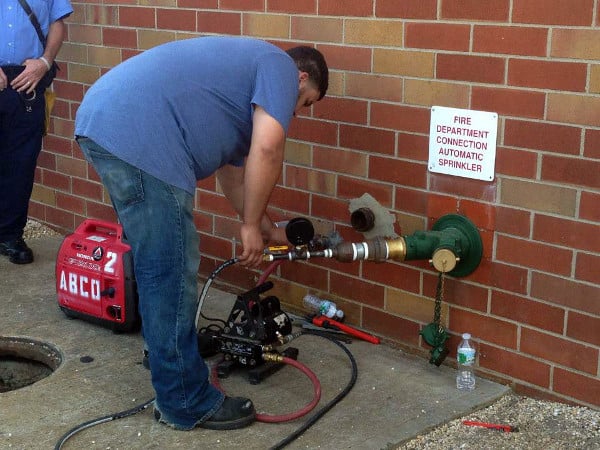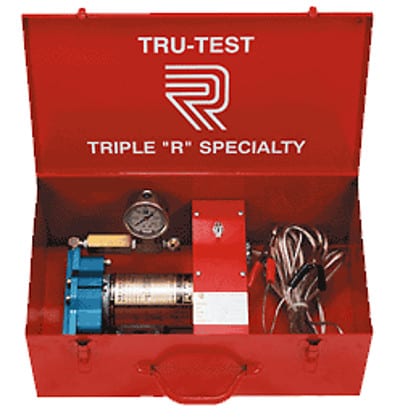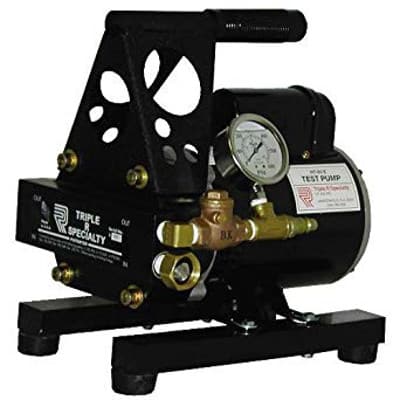Portability, durability, and power source make some hydrostatic test pumps better for some jobs than others
Leaks — whether they’re in a sewer system, a plumbing set-up, or fire sprinkler and standpipe systems — can kill the performance of water-based systems, lead to structural damage, and make a building unsafe. Hydrostatic tests prove that a system is drip-free, identifying problems that can be overlooked during a visual inspection. In this article, we look at the hydrostatic test pump features that are important for professional contractors specializing in the installation, testing, and maintenance (ITM) of standpipes and fire sprinklers.
While all test pumps share core features, not all models provide equal power, durability, portability, or control.
If you’re shopping for a hydrostatic test pump, feel free to skip directly to our selection, including lightweight Tru-Test models (250 PSI/2.2 GPM) and more powerful HT-454 (400 PSI/3.0 GPM), HT90E, and HT89A models (both at 300 PSI/3.0 GPM).
Water pours into an industrial building through an opening left by a missing fire sprinkler head. A hydrostatic test would have of course identified a problem like this — as well as any loose fittings or damaged pipe — prior to system acceptance.
Hydrostatic test pump features: the necessary pressure and flow rates vary with the size of the system
The two most critical specs for a hydrostatic test pump are the maximum pressure in pounds per square inch (PSI) and the volume in gallons per minute (GPM) that the pump can move. Larger, more powerful gas-powered pumps generally have higher horsepower (HP), PSI, and GPM, and can more quickly pressurize larger systems. Electric pumps have less HP but are more convenient, and can deliver the speed and pressure required for most fire protection system applications.
Pumps with higher GPM will add pressure to a system more quickly — and fill it faster, if needed. Our previous piece on hydrostatic testing elaborates on these factors, but the key considerations for how much pump is needed include the system size, whether or not a system is already pressurized, and the building’s height.
How heavy is your hydrostatic test pump?
Weight is a major consideration when choosing a hydrostatic test pump. Most people with a healthy back lifting from waist height — say, from the back of a truck bed — can safely and repeatedly pick up 70 pounds with good technique. The maximum safe load becomes significantly less when picking that object back up at ground level: about 20 pounds or lower for repeated lifting.
Some lighter hydrostatic test pumps are designed with a handle that enables carrying them with a single hand, while large-dimension and heavier pumps may require two people to lift them and are often mounted on wheels. In general, weight increases with the power of the pump. However, there are also big differences in weight and size between many otherwise comparable pumps.
Aluminum pump components are considerably lighter than those made from other metals; a cubic foot of aluminum weighs roughly three times less than the same volume of copper, iron, or steel. In addition to being lighter, pumps that use aluminum are much more resistant to freeze damage; some older models have casings made of cast iron or other metals that can crack when vibrating in freezing temperatures. Compact models can also be built without metal cases, roll cages, or other protective components that make pumps larger and heavier.
Common pumps rated at between 220 psi and 500 psi provide all the pressure required for nearly all fire sprinkler and standpipe testing applications — and many can provide that power at a weight under 40 pounds. Models powered by hand or a cordless or electric drill, for example, can weigh less than 10 pounds but have a low GPM (less than 2.0). While it’s certainly possible to conduct hydrostatic tests with these pumps, their limited power (along with the inconvenience of needing to hand-pump or squeeze the drill’s trigger) makes them a less common choice.
On the other hand, kit-style pumps enclosed in a carrying case strike a balance between power and portability. For example, Triple R’s Tru-Test pump weighs only 22 pounds, including the protective metal case.
The weight of larger electric models varies significantly. Both Triple R and Reed manufacture pumps in the 250 psi to 500 psi range with weights of just over 30 pounds. Triple R’s HT-90E weighs only 32 lbs., while the Triple R HT 89-A weighs slightly more (35 lbs.). Both of them weigh less than their competitors:
- Reed EHTP500 – 37.5 lbs.
- Reed EHTP500C – 48 lbs.
- Rice EL1 – 58 lbs.
- Rice EL1A – 74 lbs.
The weight of the latter three models is high, in part, because they are built with a roll cage.
Pump hoses and electric cords are hydrostatic test pump features that provide flexibility
Every hydrostatic test pump needs both a supply of energy and a supply of water. Pumps powered by gas and those that are hooked up to a battery can operate in buildings that don’t yet have a functioning power source. Long lengths of cable (like the 25 feet included with Triple R’s 12-Volt Tru-Test pump) facilitate connections over a long distance and make it easier to connect to a battery in a parked vehicle. Meanwhile, other electric pumps have shorter lengths of cord — in the neighborhood of six feet — that can be coupled with standard extension cords.
Hydrostatic test pumps use both outlet and inlet (supply) hoses to move water from the source to the system undergoing testing. Outlet hoses connect pumps to the fire sprinkler, standpipe, or plumbing system undergoing testing and, when supplied, are designed to withstand high pressures. Inlet hoses — typically threaded with basic garden-hose connections — connect the water source to the pump. Because longer lengths of supply hose may collapse due to suction, a sturdy and short hose (read: not a full-length garden hose) may offer better performance.
The hose length included with hydrostatic test pumps varies with each manufacturer: Rice’s model EL series ships without a hose by default, Reed’s electric hydrostatic test pumps include 15 feet of outlet hose, and Triple R supplies 10 feet of quick disconnect outlet hose with all models and 5 feet of supply hose with the HT-454 and Tru-Test.
A quick-disconnect coupling includes a one-way valve that allows the hose to separate easily from the pump, which comes in handy when demonstrating to fire officials that the system is successfully maintaining pressure. It’s worth noting that the threaded end that connects the hose to the system is smaller than the 2 1/2″ NPT-threaded swivel found on most FDCs, where many systems will be tested. Additional reducers or adapters will be needed.

Hydrostatic test pump features that maintain and manage pressure
Hydrostatic test pumps need some way of maintaining system pressure after disconnecting the supply line or outlet hose. Some pumps close off that pressure using a manually-operated valve at the supply line. Others use an in-line check valve which activates automatically when water flows in the wrong direction (as happens when shutting off a pump). Supply hoses also typically feed into a suction-side strainer that blocks debris from the water supply; this prevents damage to the pump and the possibility of clog-caused flooding.
Certain pumps, such as Triple R’s HT-89A, have a pressure regulator designed to keep system pressure in check. This can be set to detect when the outlet pressure reaches a specific number and then automatically close off the supply; a full-flow bypass diverts water directed at the outlet hose back into the pump itself. Pressure regulators are a useful fail-safe and don’t require minute-by-minute monitoring, but it’s still important to keep an occasional eye on the pump, as friction from recirculation causes water to become increasingly hot. You wouldn’t want the bypass to operate for a full 45 minutes, for example. Nevertheless, a pressure regulator is a great feature that can prevent damage to the pump and free you up to do other tasks.
Liquid-filled pressure gauges ensure durability and readability
Hydrostatic test pumps should include a gauge used to indicate the pressure being supplied to the system (unlike system pressure, which is measured using a separate gauge). Liquid-filled gauges use silicone, glycerin, or other substances to stabilize the gauge’s needle.
Like pretty much every pump, hydrostatic test pumps have moving components that pulse, vibrate, and generate heat. These forces slowly damage the sensitive parts on a gauge, including links and pivots. Vibration can lead to permanent damage and inaccurate readings and is, in fact, the leading cause of gauge failure. Liquid-filled gauges also limit the build-up of condensation, lubricate moving parts, and protect against sudden changes in temperature.
This short video models vibration’s effects on a gauge’s internal components:
But if dry gauges lack all of these benefits, then why aren’t all gauges liquid-filled?
While liquid-filled gauges offer substantial improvements to gauge life and performance, dry models don’t run the risk of leaking, have no fill line, and never need to be refilled. They can also operate at as low as -40 degrees Fahrenheit, whereas liquid-filled gauges generally have higher minimum operating temperatures (around -4 degrees Fahrenheit). These temperatures aren’t an issue in most hydrostatic test pump applications, however, so it’s typically best to opt for a liquid-filled gauge.
Portable, light, and durable hydrostatic pumps for standpipes and fire sprinklers
There are a number of hydrostatic test pumps on the market that can get the job done. But QRFS supplies four of the most user-friendly, lightweight, and reliable models for tests of fire sprinkler and standpipe systems.
Triple R’s Tru-Test delivers on the best of many hydrostatic test pump features described above: these pumps weigh only 22 pounds, come in a durable carrying case, feature a liquid-filled gauge, and include substantial lengths of cord and hose. Both the electric 120-volt Tru-Test and 12-volt Tru-Test move 2.2 GPM at up to 250 PSI, and the 12-volt model can be hooked to a car battery for power-source convenience.
Triple R’s HT-89A and 90E are some of the lightest pumps in their PSI/GPM class. The HT-90E operates at 3.0 GPM and 300 PSI and is designed to be carried with a single-handed grip. The HT-89A is almost identical to the HT-90E but also has a pressure regulator to ensure that the pump doesn’t exceed the target pressure. Finally, the HT-454 is rated at 400 PSI and 3.0 GPM, has a compact design of only 12″x12″x8″, and, like the Tru-Test, features a protective case and 5’ of inlet hose.
To learn more about choosing the right model and QRFS’s hydrostatic test pumps, give us a call at 888.392.3362, email support@qrfs.com, or fill out our contact form.
This blog was originally posted at blog.QRFS.com. If this article helped you, check us out at Facebook.com/QuickResponseFireSupply or on Twitter @QuickResponseFS.




